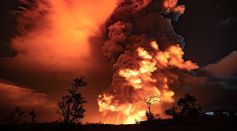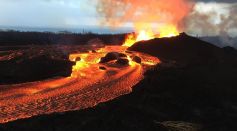Tags: Kilauea Volcano

Kilauea Volcanic Eruption Finally Ceased After 61 Days; USGS Confirms Lava No Longer Flowing

Lava Sound Serves as Music to Volcanologist’s Ears; New Study Describes the Rhythms Behind Kīlauea Volcano’s 10-Year Eruption

Kīlauea Origin: Analysis Suggests the World's Most Active Volcano Was Born from Pyroclastic Materials Nearly 100 Kilometers Deep
Satellite Captured Glowing Lava Inside Erupting Kilauea Volcano in Hawaii; USGS HVO Records Magnitude-6.2 Earthquake, Aftershocks
Scientists Tests Laws of Friction To Understand Caldera Collapse During Kilauea Volcano Eruption in 2018

Hawaii’s Kilauea Erupts, Authorities Warn of “Significant Emission” Possibility

Deadly Lava Lake Is Bubbling in Hawaii's Kilauea Volcano Hitting Extreme Temperatures
[Study] Hawaiian Volcano is Causing the Earth's Crust to Sink: Is Another Volcanic Eruption Coming?

Study Shows Heavy Rains Triggered Devastating 2018 Kīlauea Eruption in Hawaii
Hawaii's Kilauea Volcano Continuously Spews Out 'Firehose' Of Lava Into The Pacific After Lava Tube Was Exposed [VIDEO]
Seismic Changes on Hawaii’s Kilauea Volcano Prompt Warnings And New Research
What’s the Worst Case Scenario? Hawaii’s Kilauea Lava Flow
Hawaiian Lava Flow Prompts Evacuation on Big Island
Most Popular

How Electric Vehicles vs Gasoline Cars Compare on Carbon Emissions and Green Transportation

Why Solar Maximum Drives More CMEs: Sunspot Activity and the Solar Cycle 25 Breakdown

How Solar Flares and CMEs Affect Life on Earth: 10 Space Weather Impacts Explained

How Long EV Batteries Really Last and What Lithium-Ion Degradation Means for Battery Health





